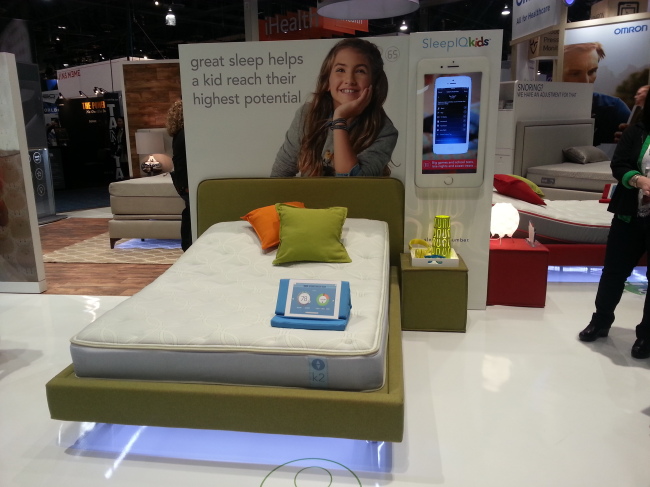LAS VEGAS ― Brimming with cross-industry innovations, this year’s International CES, the world’s largest electronics trade show, was a hotbed of collaboration and technological convergence.
From tennis rackets, watches, jewelry and clothing to household appliances, the event showed how conventional products were getting high-tech upgrades for the coming era of the Internet of Things.
One noticeable feature of this year’s CES, which closed Friday, was the slew of technological collaborations for a better night’s sleep.
SleepIQ Kids, a smart bed developed by Sleep Number, a U.S.-based smart-bed-maker, helps parents view comprehensive information on their kids’ sleep, including average heart rate, average breathing rate, movements and bed exits.
 |
SleepIQ Kids, a smart bed developed by Sleep Number (Kim Young-won/The Korea Herald) |
Motion and heart rate sensors embedded in the SleepIQ bed directly send that information to smartphones so that parents can easily track their kids’ sleep patterns and keep the boogeyman away.
“The smartphone app for the bed also alerts you when your kids get out of bed, which will help you keep an eye on your kids,” a Sleep Number official said at the company’s booth at the electronics show.
Somfit, a sleep and fitness tracker the size of a small coin, was another interesting product on display aimed at improving sleep quality.
The device, which comes along with a bandage, can be attached to a user’s forehead. It monitors brain waves, detects room sounds and temperature, and analyzes all this information to provide medical-grade data for users. It also measures durations of different sleep stages including rapid eye movement (also known as dream sleep), which is important for learning and memory, and deep sleep, which is important for physical recovery.
“Different from other gadgets for sleep based mostly only on motion sensors, Somfit provides as accurate data as those for medical purposes,” said Gerald Lim Tuck-Cheun, the global marketing manager of Compumedics, the Australia-based developer of Somfit.
The CES also featured information technology integrated with sports and fashion.
The iSetWatch, produced by France-based iSet, is the world’s first smart tennis score counter, which enables its users to share game results and histories with their friends.
The square screen serves as a scoreboard, with the upper part showing points that one player earns in a match and the lower part showing the other player’s points.
“Scores counted by the smart watch can be shared in real time with others through smartphones,” said Didier Jousserand, cofounder and marketing director of iSet.
“A series of game results recorded on the watch allows users to track their progress, and the users can improve their performance as well.”
The smart score counter lets users set the number of sets and games per set and adjust the specific rules of the matches, including advantage and tie break.
It also features a replaceable battery used for an average wristwatch, which can last for up to two years.
 |
Fitness tracking crystal Swarovski Shine is displayed at the International CES in Las Vegas. (Kim Young-won/The Korea Herald) |
Swarovski, a crystal jewelry-maker, partnered with fitness tracker firm Misfit to bring its glamor to Misfit’s fitness device Shine.
Hidden under the gleaming crystal are motion sensors, and glimmering light-emitting diodes, also featured in the normal Shine.
The solar-powered fitness tracker is water-resistant and can be fitted on a watch band, bracelet or necklace.
“Observing the high-tech market, we felt the opportunity to inject an aesthetic added-value that would turn useful products into on-trend accessories,” Joan Ng, senior vice president APAC product marketing, responsible for the collaborative project, said in a press release.
“Working with Misfit was a fantastic experience which ensured us the uncompromised quality we as a brand are committed to.”
By Kim Young-won, Korea Herald correspondent
(
wone0102@heraldcorp.com)









